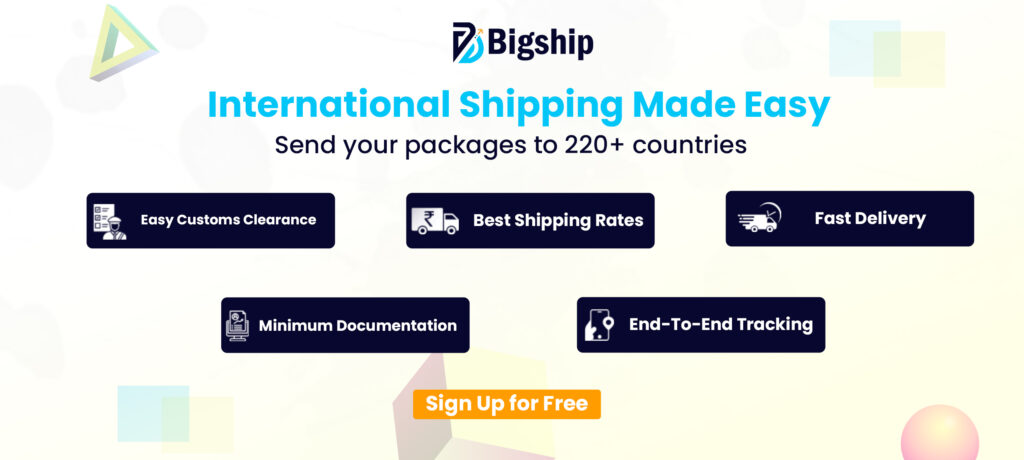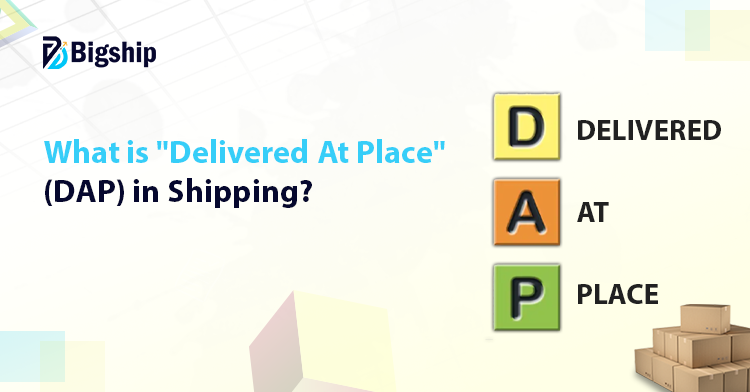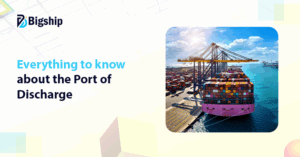When you buy or sell goods across borders, there’s always one big question, who does what? That’s where Delivered at Place or DAP incoterm, or international commercial term, steps in. These are international commercial terms that clear up confusion between buyers and sellers.
The DAP Incoterms meaning is simple, the seller takes charge of getting the goods to the place both parties agreed on, and the buyer handles things from there. DAP shipping works well in many trade situations. It’s clear, flexible, and trusted by businesses worldwide. If you’re importing something and want the seller to manage most of the journey, DAP is often the choice.

This blog will walk you through every part of DAP, from how it works to what the buyer and the seller must do, so that no one faces surprises later.
What does incoterm DAP shipping mean?
You might see the term “DAP” in shipping when sending or receiving goods from another country. DAP full form in shipping is Delivered at Place. This rule comes from a set of international shipping terms called Incoterms. These terms help both buyers and sellers know who handles what during the shipping process.
Incoterm DAP means the seller takes care of the shipment until it reaches the place agreed on by the seller and buyer. That place could be a warehouse, an office, or any chosen location. The seller pays for the transport and takes the risk if anything goes wrong during shipping. The buyer only steps in once the goods reach that final spot.
DAP in shipping is common in international trade. It works for sea, air, rail, or road transport. The seller arranges everything, from packing and loading to moving the goods across countries. But once the shipment reaches the destination, the buyer’s job begins. The buyer needs to handle customs, pay import duties, and arrange for unloading.
Obligations of sellers and buyers under incoterm DAP
Under DAP shipping, both the buyer and seller have specific jobs to do. These roles are clearly divided so there’s no confusion during the export process.
What are seller’s responsibilities?
The seller handles the goods until they reach the chosen location. Here’s what the seller takes care of under DAP terms in export:
Transport to the Port: The seller pays to move the goods from their site to the port of departure.
Export Customs: The seller clears the goods for export. They arrange documents like the bill of lading and invoice.
Shipping to Destination Country: They pay for the main shipping cost to get the goods to the destination country’s port.
Optional Insurance: Insurance is not required, but the seller may still insure the goods during shipping.
Risk Until Delivery: The seller holds the risk until the goods reach the destination location.
What are buyer’s responsibilities?
The buyer’s part begins once the goods arrive at the chosen spot. Here’s what the buyer handles under DAP shipping:
Import Duties and Clearance: The buyer deals with customs in the destination country. This includes duties, taxes, and fees.
Unloading: The buyer arranges and pays for unloading the goods at the chosen place.
Further Transport: If the goods need to move beyond the delivery spot, the buyer manages that.
Risk After Delivery: Once the seller delivers the goods, the buyer takes on any risk that occurs after that.
How does Delivered-at-Place (DAP) in shipping work?
The buyer and the seller might be in different countries or maybe in the same one. Either way, trade rules still matter, and that’s where DAP shipping comes in. It’s one of the Incoterms used in export deals. These terms define what each side must do.
Under DAP terms in export, the seller does most of the work. They handle packing, export papers, loading, and the shipping process. They also take care of export approvals. The seller covers the costs and risk until the goods reach the spot you both agreed on.
The buyer’s role begins after the goods arrive. The buyer needs to pay for unloading and also have to manage the customs process in the destination country. That includes import duties, taxes, and any related documents.
DAP shipping works across all transport types. It doesn’t matter if the goods move by ship, plane, train, or truck. The location where the seller delivers the goods is clearly written. For example, “Delivered at Place, Port of Dubai.” In short, the seller brings the goods to the buyer’s place, and the buyer handles things after that.
Advantages and disadvantages of DAP in shipping
DAP shipping has some clear benefits for you as a buyer. But it also comes with a few downsides. Let’s check both sides of incoterm DAP.
Advantages
Clear Cost Division: Both parties know exactly what they’re paying for. The seller pays for everything until the goods reach your place. The buyer only covers costs after delivery.
Lower Risk During Shipping: The seller handles the risk until the shipment reaches you. That means if anything happens on the way, it’s not the buyer’s loss.
Better Cash Flow: The buyer doesn’t need to pay upfront. In some deals, the buyer can pay only after the goods arrive.
Smaller Stock and Faster Delivery: The buyer doesn’t need to wait for the shipment from another country each time. This saves space and helps the buyer manage inventory better.
Disadvantages
Customs Delays: The buyer must handle customs once the goods reach the destination country. If there’s a delay, it holds up delivery.
Extra Costs After Arrival: If there’s a delay in unloading or clearance, the buyer will pay for storage or late fees.
Higher Overall Shipping Cost: Since the seller handles more of the process, the total shipping price may be higher.
Seller’s Risk and Seller’s Charges: The seller might ask for extra payment or a deposit. They do this to protect themselves in case you refuse to pay import duties.
Where is DAP commonly used in global trade?
DAP shipping is used in many trade situations. It gives flexibility to both the buyer and the seller. That’s why it fits well in different kinds of shipments.
Used Across All Transport Modes: One big benefit of Incoterms DAP is that it works for sea, air, road, and rail. The buyer and the seller can pick the most suitable option based on cost, time, or location.
Ideal for Fragile Goods: DAP is often used when shipping breakable items. The seller keeps control until delivery, so they can take extra care and avoid damage during the trip.
Useful in Hard-to-Reach Markets: Sometimes, buyers don’t have strong logistics setups. In those cases, sellers prefer Delivered At Place or DAP, because they can handle the full journey and make sure the goods reach the right place.
Helpful for Intermodal Shipments: When goods move through more than one transport type, like sea to road or rail to air, DAP works well.
Key differences of DAP with Other Incoterms
DAP shipping stands apart from many other Incoterms. It gives more control to the seller during transport, but there are some key differences you should know when comparing DAP with DDP and CIF.
DAP vs. DDP (Delivered Duty Paid)
- In DDP, the seller pays for everything, including import duties and taxes. The seller delivers the goods fully cleared through customs.
- In DAP, the seller delivers the goods to your location but does not handle customs clearance. The buyer takes care of the import duties and taxes after the goods arrive.
DAP vs. CIF (Cost, Insurance, and Freight)
- CIF is used only for sea or inland water transport. In CIF, the seller pays for transport and insurance but hands over risk to the buyer once the goods are loaded onto the ship.
- DAP works for all types of transport, sea, air, rail, or road. The seller keeps the risk until the goods reach the final destination.
Key Takeaways
- DAP Incoterm meaning is “Delivered at Place”, where the seller handles all shipping steps until the goods reach the buyer’s location.
- Under DAP shipping, the buyer takes over after delivery and handles customs clearance, import duties, and unloading.
- DAP works with all transport types, sea, air, road, and rail, thus making it flexible for global trade.
- Sellers carry full risk and cost until delivery, giving buyers more safety during transit.
- DAP differs from DDP and CIF in risk, customs responsibility, and transport type.
How Bigship helps you start exports with ease?
Bigship makes DAP shipping simple for your export journey. You don’t need to worry about finding the right courier, preparing paperwork, or handling international delivery. Bigship connects you with 30+ trusted logistics partners who deliver across 190+ countries. It gives you real-time tracking, fast pickups, and help with customs documentation. You can manage all orders in just one dashboard.
Conclusion
DAP shipping clears up confusion in international trade. It shows who handles which part of the journey. The seller takes care of transport till the delivery point. The buyer handles customs and unloading after that. It’s a good choice if you want less risk during shipping.
Bigship provides you with reliable delivery, full support, and access to global couriers. Sign up now and start exporting with Bigship and make your shipping process smooth and clear.
FAQs
What is the DAP Incoterms meaning?
DAP stands for “Delivered at Place”. It means the seller delivers goods to a location agreed with the buyer.
Who pays for customs under DAP shipping?
The buyer pays for import customs duties, taxes, and handles clearance once the goods arrive.
Does DAP apply to all transport types?
Yes, DAP works for sea, air, road, rail, or a mix of them.





